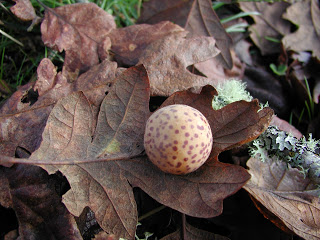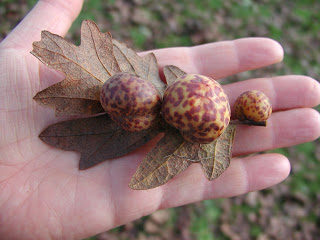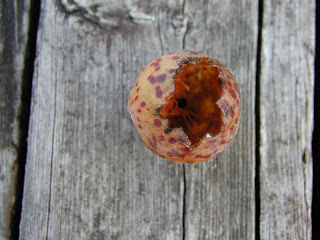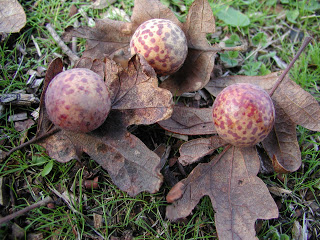Have you ever noticed these strange round balls while your feet crunch along through the oak leaves in the fall? When I first moved here I had no idea what they were. Perhaps some strange fruit produced by oak trees? My kids thought they were fascinating. Maybe they were some sort of little fairy balls? I soon learned that these were oak galls. What, you might wonder, is an oak gall? Well, dear readers, I will tell you.
Our native oak trees, Quercus garryana, or Oregon White Oak hosts an abnormal growth called a gall, formed by the Oregon Oak Gall Wasp (Besbicus mirabilis). These little wasps actually change the hormonal make-up and growth of the plant, causing it to create a nice little home for their larvae to grow up in until they’re ready to make their way out into the world.
I found some more detailed info on one website called Paul and Bernice Noll’s Window on the World:
“Galls are modified plant tissue. This tissue is often highly elaborate, species-distinctive and host-specific. Most galls form when the invading organism causes hormonal changes in the plant, which stimulates rapid abnormal plant growth. These abnormal growths divert food away from normal tissues, weakening the plant. Moreover, the fast rate of growth may also crush normal tissues, cutting off sap flow or otherwise interfering with plant function. Galls serve as both a food source and shelters for these organisms. The galls found on our oak trees are cause by a cynipid wasp. Female cynipids lay their eggs in into actively growing meristematic tissue. The wasp larva uses the gall as shelter and feeds on the gall tissue. It pupates within the gall, and then the adult chews an exit hole to emerge. These galls do not cause major damage to the tree. The best way to gain control of this problem is to prune out the affected areas and destroy the galls.”
There are so many different little homes all around us in nature. It’s really kind of wild when you think about it. So, the next time you notice these oak galls lying around on the ground, stop and check one out. If you have kids, let them bring one home to study, or just to decorate your fall nature table. They really are quite beautiful with their shiny reddish brown spots and almost perfect roundness. It’s amazing what a tiny little bug can do.





Thanks for the post! i live in Battle Ground, WA, and have wondered what these were. Now I know!
We had an oak tree at the house I grew up in that had these (I distinctly remember the reddish spots). As a kid I didn't know what they were either, but I liked breaking them apart. IIRC they had fuzzy stuff inside.
They sure are a lot of fun! I didn't grow up around oaks, but I know I would have been all about these!
When I was a little girl, we would gather these, what we called “ink balls,” stick a bird’s feather in them, and draw or write with the purplish ink we got from inside them, ( before they became dry and crunchy.) Who knew that such a simple childhood pasttime has such a very scientific explanation! I am forever grateful for my childhood, playing outside in nature, using my imagination.